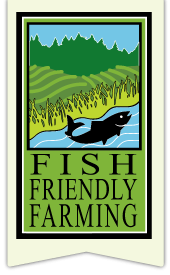FAQs
What is the geographic scope of the FFF Program?
The FFF Program presently operates in ten counties including Mendocino, Sonoma, Napa, Placer, Amador, El Dorado, Humboldt, Santa Clara, Kern and Solano Counties. CLSI is currently developing a version of the FFF program for the Sacramento-San Joaquin Delta.
Are all the growers in a region eligible?
Yes, enrollment to the workshops is open to everyone, but there is no guarantee of certification.
Is there an assessment component of the Program, or is it covered under the development of the Farm Conservation Plan?
There are a number of elements in the Farm Conservation Plan addressing different aspects of the property, from roads to creeks to vineyard/orchard/field management. Not every element applies to every site. There is an extensive and detailed assessment and inventory of the natural features of the site and the management practices used. All creeks, including ephemeral and seasonal creeks, are assessed. Every road and every road culvert is inventoried. Although vineyards/orchards/fields are included, the focus is on the entire property and conditions on the entire property are assessed.
Is the Farm Conservation Plan completed entirely by the farmer, or is there technical assistance? What kind of technical support is available and from whom -- either for completing the farm conservation plan or for implementation?
The FFF program is not intended as a self-assessment by the farmer. Each owner/manager enrolls their property in the Program and attends workshops that review the Program assessment and BMPs (Beneficial Management Practices). The workshop instructor and technical staff then complete a site visit. The farmer works with the FFF program staff to complete the assessment and documentation of vineyard/orchard/field management practices and all maps. The FFF program scientists complete all the technical sections of the Farm Conservation Plan: road assessment and repair, riparian corridor evaluations and restoration/revegetation, ephemeral creek erosion control and revegetation, erosion site evaluation and repair, retrofit of reservoirs and many other items.
Once the Farm Conservation Plan is completed, it is reviewed prior to the certification. Each Farm Conservation Plan element includes an implementation timeline that lists the management practices and projects and how and when they will be implemented. Major projects have up to 10 years to be implemented; changes in management practices must be implemented in 2-3 years. The FFF Program will work with the grower to apply for grants and permits for major projects. In our experience, the farmer implements the majority of the needed changes and fewer than 25% of Farm Conservation Plans generate major cost-share projects.
Are there any procedures for monitoring compliance, other than re-certification? How does re-certification work?
Each Farm Conservation Plan contains a photo-monitoring element with established monitoring points. There is a list of the features that must be photographed and labeled each year. Implementation of all BMPs and projects are photographed. An annual on-line audit of site conditions is also required.
Re-certification involves checking that substantial progress has been made in implementing the Farm Plan and that management practices continue to follow the FFF program requirements.
Are there any financial incentives for participation?
The farmer receives substantial technical assistance. The owner may also receive funding for projects. The certification from regulatory agencies provides certainty and assurance that the actions called for in the Farm Conservation Plan provide for compliance with state and federal water quality and endangered species laws. There is a great deal of interest by landowners in gaining this assurance. There is also an advantage in those watersheds with Total Maximum Daily Load (TMDL) regulatory programs, including the Napa, Russian, Gualala and Navarro River and Sonoma Creek watersheds. The Farm Conservation Plan and photo-monitoring allows the owner to demonstrate compliance with the TMDL for the watershed and a reduction in contaminant loading from the property. The entire FFF Program is designed for self-directed compliance with state and federal environmental laws and to create a record of improvements through the Farm Conservation Plan and photo-monitoring of the property.
How many farms have been certified?
As of December 2017, over 800 properties totaling more than 98,000 acres have been certified in the 10 counties. Total enrollment has reached over 150,000 acres.
How do landowners and managers enroll in the Fish Friendly Farming program?
Contact the California Land Stewardship Institute at 707-253-1226 or send an e-mail through our Contact Page. You can also download a sign up form for your county, fill it out and email to info [at] fishfriendlyfarming.org or fax to 707-253-1708.

